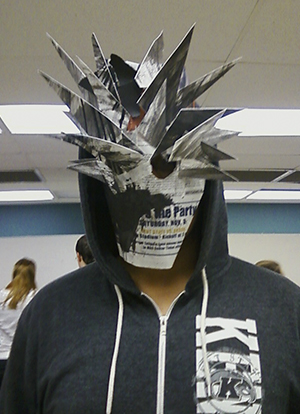Halloween fun in Taylor Hall

Pedro Rojas, 1st place. Photo by Kirsten Bowers.
November 1, 2012
Students competed in an in-class design competition on Halloween night in the fourth floor studio of Taylor Hall.
The students arrived for their Design Thinking I course, but were told to create a mask that could stay on their face in 30 minutes.
Students were allowed to use a Daily Kent Stater, three white index cards, a five-by-seven postcard and anything they could find on the floor.
“I love it,” said Pamela Evans, interim associate dean of Architecture and Environmental Design. “They’re cleaning the floor.”
Students designed masks that resembled elephants, cats, Pac-Man characters, Batman villains and even Mitt Romney and Barack Obama.
Students said they enjoyed the activity.
“It’s a good relief from studio and all our classes in general,” said Hannah Henry, freshman architecture major.
When time was up, students were grouped together based on their studio instructor and lined up in front of a panel of eight judges.
The judges picked two or three masks from each section to continue into the finals. The judges had the finalists line up and chose the top three to win AllMedia gift cards.
AllMedia is a store the students go to purchase supplies for their projects. The possibility of saving money on supplies got students even more excited.
Pedro Rojas, freshman architectural studies major, won first place for his mask that judges described as “the spiked mask.”
“I was just throwing random stuff together and kept going,” Rojas said.
Barbara Russell, freshman architecture major, won second place for her silver mask.
“I wanted [the mask] to be scary,” Russell said. “I thought big teeth, and you can’t really see the eyes, so I thought that would be scary.”
The third place winner was Victoria Melli, sophomore interior design major, for her mask that was made to look like a shark.
“I initially just made a hat,” Melli said. “It looked like a shark, so I decided to go off of it.”
Evans said the purpose was for the students to apply what they have been learning in Design Thinking and apply it to the human shape. She said it also teaches students about using unconventional materials.
“[Students learn] good design doesn’t need to come from expensive materials,” Evans said. “It can come from found objects and scrap materials.”
Kirsten Bowers is the Architecture and Environmental design reporter for the Daily Kent Stater.
Contact Kirsten Bowers at [email protected].
























